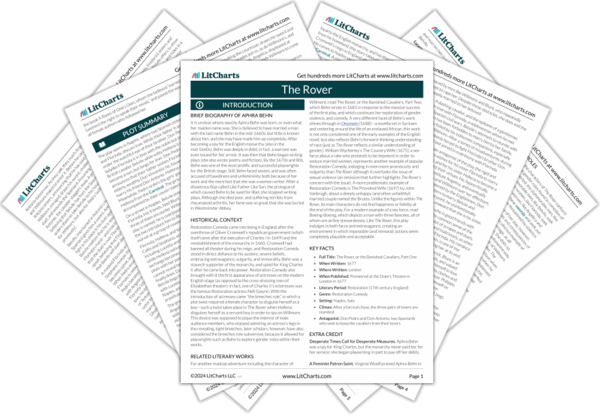
Welcome to the LitCharts study guide on Aphra Behn's The Rover. Created by the original team behind SparkNotes, LitCharts are the world's best literature guides.
It is unclear where exactly Aphra Behn was born, or even what her maiden name was. She is believed to have married a man with the last name Behn in the mid-1660s, but little is known about him, and she may have made him up completely. After becoming a spy for the English monarchy (also in the mid-1660s), Behn was deeply in debt; in fact, a warrant was even issued for her arrest. It was then that Behn began writing plays (she also wrote poetry and fiction). By the 1670s and 80s, Behn was one of the most prolific and successful playwrights for the British stage. Still, Behn faced sexism, and was often accused of bawdiness and unfemininity both because of her work and the mere fact that she was a women writer. After a disastrous flop called Like Father Like Son, the prologue of which caused Behn to be sued for libel, she stopped writing plays. Although she died poor, and suffering terribly from rheumatoid arthritis, her fame was so great that she was buried in Westminster Abbey.
Get the entire The Rover LitChart as a printable PDF."My students can't get enough of your charts and their results have gone through the roof." -Graham S.

Restoration Comedy came into being in England after the overthrow of Oliver Cromwell’s republican government (which itself came after the execution of Charles I in 1649) and the reestablishment of the monarchy in 1660. Cromwell had banned all theater during his reign, and Restoration Comedy stood in direct defiance to his austere, severe beliefs, embracing extravagance, vulgarity, and immorality. Behn was a staunch supporter of the monarchy, and spied for King Charles II after he came back into power. Restoration Comedy also brought with it the first appearance of actresses on the modern English stage (as opposed to the cross-dressing men of Elizabethan theater); in fact, one of Charles II’s mistresses was the famous Restoration actress Nell Gwynn. With the introduction of actresses came “the breeches role,” in which a plot twist required a female character to disguise herself as a boy—such a twist takes place in The Rover when Hellena disguises herself as a servant boy in order to spy on Willmore. This device was supposed to pique the interest of male audience members, who enjoyed admiring an actress’s legs in the revealing, tight breeches; later scholars, however, have also considered the breeches role subversive, because it allowed for playwrights such as Behn to explore gender roles within their works.
For another madcap adventure including the character of Willmore, read The Rover, or the Banished Cavaliers, Part Two, which Behn wrote in 1681 in response to the massive success of the first play, and which continues her exploration of gender, violence, and comedy. A very different facet of Behn’s work shines through in Oroonoko (1688)—a novella set in Surinam and centering around the life of an enslaved African, this work is not only considered one of the early examples of the English novel, but also reflects Behn’s forward-thinking understanding of race (just as The Rover reflects a similar understanding of gender). William Wycherley’s The Country Wife (1675), a sex farce about a rake who pretends to be impotent in order to seduce married women, represents another example of popular Restoration Comedy, indulging in even more promiscuity and vulgarity than The Rover although it overlooks the issue of sexual violence (an omission that further highlights The Rover ’s concern with the issue). A more problematic example of Restoration Comedy is The Provoked Wife (1697) by John Vanbrugh, about a deeply unhappy (and often unfaithful) married couple named the Brutes. Unlike the figures within The Rover , its main characters do not find happiness or fidelity at the end of the play. For a modern example of a sex farce, read Boeing-Boeing, which depicts a man with three fiancées, all of whom are airline stewardesses. Like The Rover , this play indulges in both farce and extravagance, creating an environment in which impossible (and immoral) actions seem completely plausible and acceptable.
Key Facts about The RoverDesperate Times Call for Desperate Measures. Aphra Behn was a spy for King Charles, but the monarchy never paid her for her service; she began playwriting in part to pay off her debts.
A Feminist Patron Saint. Virginia Woolf praised Aphra Behn in the book A Room of One’s Own, whom she believed “earned [women] the right to speak their minds,” and paved the way for all female authors who followed her.